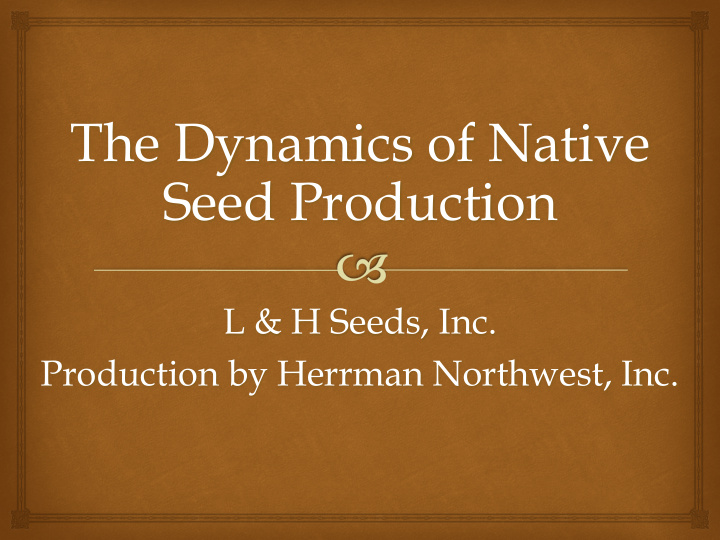



The Dynamics of Native Seed Production L & H Seeds, Inc. Production by Herrman Northwest, Inc.
Company Overview Herrman Northwest, Inc. L & H Seeds, Inc. Production history Seed production, cleaning and processing, mixing and sales Breeder and Foundation seed production for WSCIA
Quality Control Program Planting Field selection; weeds, crop history, isolation requirements Stock seed selection Cleaning and inspection of planting equipment Field Scouting Weekly inspections Chemical applications and cultural practices Rogueing crew
Quality Control Program Harvest Methods are individual to crop to ensure high quality Cleaning and inspection of harvest equipment Seed cleaning and processing Cleaning and inspection of equipment Three separate cleaning lines, gravity deck, spirals and color sorter All seed lots are tested at certified seed laboratories
Northern Basin and Range Basin Wildrye Leymus cinereus Deschutes Basin Idaho Fescue Festuca Idahoensis
White Pass Blue Wildrye Elymus glaucus Crooked River National Grassland Bottlebrush Squirreltail Elymus elymoides
Dry River Basalt Milkvetch Aridlands Maple Grove Western Prairie Clover Linum lewisii Dalea ornata Photo by Derek J. Tilley, USDA NRCS Astragalus filipes Appar Blue Flax Yakima Western Yarrow Linum perenne Achillea millefolium
Combining Swathing Mechanical harvest of whole plant Metal bins for small lots
Seed Drying Seed blending & Mixing Large scale seed cleaning Small lot seed cleaning
Stock Seed Wild collected seed Blended Seed lots Harvest Evaluation for production potential Production practices Harvest and cleaning ease Can it provide the amount and quality of seed needed for restoration projects?
Seed Zones New research to determine seed zones by species Example: Blue Mountains 4 preliminary seed zones for Mountain Brome Allocation of production resources Scale of production Risk and reward
Information Sharing Technical guides Establishment Cultural practices Harvesting Reporting on experiments and trials Making connections Communication
Herbicides Lack of registered herbicides for use with native grasses and forbs Third Party Labeling Working with Corey Ransom A united voice = Results Increased production costs will limit production
Crop Rotation Reality Check: Fall 2010 Increased demand for CRP species Emphasis on creating habitat for native pollinators Result Shift in the allocation of land and resources Commodity price increase Limits the pool of native seed growers Low risk, low input, high pay off Increased competition for land High rents
Contracts Indefinite Delivery, Indefinite Quantity Contracts Small scale production of local source ID seed Large scale fire event Fixed period of time Investment in land and resources Established, healthy productive field Market on your own Rotate out
Working with a Co-op Berta Youtie Personal contact Open conversation Background information on species Advise on production and harvesting Flexibility Contracts can vary By the acre- entire crop By the pound- specific amount
Bottom Line Screening for traits that lend themselves to agronomic production Improved communication through out the industry Agreement on seed transfer zones Herbicide research and labeling Contracts that consider investment and risk Consideration of exterior influences
Paul Herrman PaulH@lhseeds.com 509-234-4433 Stacey Plummer StaceyP@lhseeds.com
Recommend
More recommend